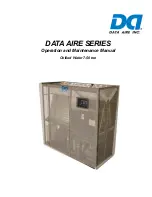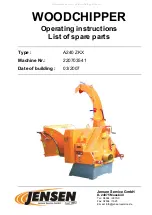
68
AC-SVX002D-EN
Cleaning section of Maintenance chapter.
N
NO
OT
TIIC
CE
E
C
Co
oiill D
Da
am
ma
ag
ge
e!!
U
Usse
e o
off d
de
ette
errg
ge
en
nttss cco
ou
ulld
d cca
au
usse
e d
da
am
ma
ag
ge
e tto
o cco
oiillss..
D
Do
o n
no
ott u
usse
e d
de
ette
errg
ge
en
nttss tto
o cclle
ea
an
n cco
oiillss.. U
Usse
e cclle
ea
an
n
w
wa
atte
err o
on
nlly
y..
Refrigerant and Oil Charge
Management
Proper oil and refrigerant charge is essential for proper
unit operation, unit performance, and environmental
protection. Only trained and licensed service personnel
should service the chiller.
The following table lists baseline measurements for
chillers running at AHRI standard operating conditions.
If chiller measurements vary significantly from values
listed below, problems may exist with refrigerant and
oil charge levels. Contact your local Trane office.
N
No
otte
e:: Low temperature applications units will have
values that vary from the following table.
Contact your local Trane office for more
information.
Table 28.
Typical baselines (AHRI conditions)
Measurement
Baseline
Evaporator Pressure
129 psia
Evaporator Saturation Temperature
38°F
Evaporator Approach
7°F
EXV Position
45% open
Evaporator DT
10°F
Condenser Pressure
435 psia
Condenser Saturation Temperature
121°F
Subcooling
15°F
Discharge Superheat
70°F
Suction Superheat
11°F
Compressor RLA
95%
Compressor RLA
100%
Lubrication System
Oil Level
Oil should also be visible in the sight glass when the
compressor is running. When operating, each
compressor in a tandem or trio set may have a different
oil level.
To check compressor oil level, refer to the label near
the compressor sight glass. The compressor(s) must be
off. Wait three minutes. With tandem or triple
compressors the oil level will equalize after shutdown.
Compressor oil level should be clearly visible within
the sight glass when the compressors are off
IIm
mp
po
orrtta
an
ntt:: If oil level is low, contact your local Trane
office. Verify that ONLY Trane OIL00080 is
used.
Oil Testing
N
NO
OT
TIIC
CE
E
C
Co
om
mp
prre
esssso
orr D
Da
am
ma
ag
ge
e!!
P
PO
OE
E o
oiill iiss h
hy
yg
grro
osscco
op
piicc –– iitt a
ab
bsso
orrb
bss w
wa
atte
err d
diirre
eccttlly
y
ffrro
om
m tth
he
e a
aiirr.. T
Th
hiiss w
wa
atte
err iiss n
ne
ea
arrlly
y iim
mp
po
ossssiib
blle
e tto
o
rre
em
mo
ov
ve
e ffrro
om
m tth
he
e cco
om
mp
prre
esssso
orr o
oiill a
an
nd
d cca
an
n rre
essu
ulltt iin
n
cco
om
mp
prre
esssso
orr ffa
aiillu
urre
ess..
T
To
o p
prre
ev
ve
en
ntt P
PO
OE
E o
oiill ffrro
om
m a
ab
bsso
orrb
biin
ng
g w
wa
atte
err,, tth
he
e
ssy
ysstte
em
m ssh
ho
ou
ulld
d n
no
ott rre
em
ma
aiin
n o
op
pe
en
n ffo
orr llo
on
ng
ge
err tth
ha
an
n
n
ne
ecce
essssa
arry
y.. W
Wh
he
en
n o
op
pe
en
n,, d
drry
y n
niittrro
og
ge
en
n ssh
ho
ou
ulld
d ffllo
ow
w
tth
hrro
ou
ug
gh
h tth
he
e p
piip
piin
ng
g.. O
On
nlly
y n
ne
ew
w o
oiill cco
on
ntta
aiin
ne
errss ssh
ho
ou
ulld
d
b
be
e u
usse
ed
d ffo
orr sse
errv
viicce
e a
an
nd
d m
ma
aiin
ntte
en
na
an
ncce
e.. A
Allw
wa
ay
yss u
usse
e
tth
he
e ssm
ma
alllle
esstt cco
on
ntta
aiin
ne
err ssiizze
e rre
eq
qu
uiirre
ed
d ffo
orr tth
he
e jjo
ob
b
rre
eq
qu
uiirre
em
me
en
nttss.. A
Allw
wa
ay
yss lle
ea
av
ve
e tth
he
e o
oiill cco
on
ntta
aiin
ne
err
ttiig
gh
httlly
y sse
ea
alle
ed
d u
un
nttiill ttiim
me
e o
off u
usse
e.. D
Do
o n
no
ott rre
eu
usse
e o
oiill
tth
ha
att h
ha
ass b
be
ee
en
n o
op
pe
en
ne
ed
d..
Use Trane Oil Testing Kit KIT06815 only for testing
lubricating oil. Note that:
•
The POE oil used in this product is very hygroscopic
and easily absorbs and retains moisture. The
acceptable moisture content is less than 100 ppm
and acceptable acid level is less than 0.5 TAN.
•
Refrigerant and moisture is very difficult to remove
from this oil using vacuum
•
Once the seal on a container of POE oil is opened,
the oil must be used
IIm
mp
po
orrtta
an
ntt:: In the event of a compressor failure, always
test the oil with an acid test kit to determine
whether the compressor failure was
mechanical or electrical. This information is
required to determine the correct cleanup
procedure.
Condenser Maintenance
Condenser Coil Cleaning
For information regarding the proper microchannel coil
cleaning procedure, refer to RF-SVG001*-EN.
Coil Cleaning Interval
Clean condenser coils at least once a year or more
frequently if it is in a "dirty" environment. A clean
condenser coil will help maintain chiller operating
efficiency.
Содержание Ascend ACS 140
Страница 87: ...AC SVX002D EN 87 N No ot te es s...
















































